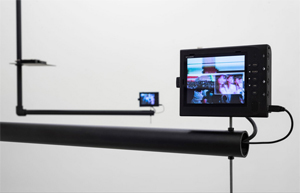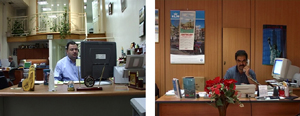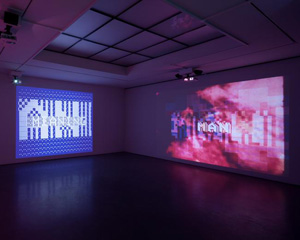The Revolution Has Been Televised
John Haberin New York City
Signals, and Refigured, and New Media
"The revolution will not be televised." Gil Scott-Heron meant it as a wake-up call to a complacent, white America, but he was wrong—and he should know. He would never have turned his 1970 poem into a single if he did not want airplay, if only on FM radio. Just imagine what he could have done on TV.
The revolution has been televised, again and again, enough to fill a museum's entire floor. That can mean the revolution in the art called new media or revolutions in nations. Tiffany Sia supplies the view from the ground on the way into "Signals," at the Museum of Modern Art—with all the ensuing backlash and repression. Yet the record remains, in a show subtitled "How Video Transformed the World." It remains repetitive, maddening, and confusing as well, and it can become a tool of the state and of advertisers at that. Yet the work itself fights back, and so do the high-tech artists in "Refigured" at the Whitney. 
Embracing cacophony
Stop me if you have heard this before. Listen carefully if you have not. A new medium promises to give voice to anyone who wants it, before the cacophony of voices drowns out everyone and gives way to an establishment of its own. It happened with movable type and the printing press—or thousands of years before that, with the women of Mesopotamia. It happened again with radio, TV, and the Internet. You would not be reading my review without it.
MoMA tells much the same story, but without the long view. Wall text warns of "systems of control" and "the all-seeing oculus of facial recognition and biometric surveillance." Yet the curators, Stuart Comer and Michelle Kuo, relish the cacophony. One might well hear nothing else, in a show without chronology and the loosest of themes. Its art all but blends into a single dull roar. They mean it, though, as a step toward "new models of public life," and they find some awfully goodones.
They are searching, too, for something less public, models of artistic expression. The exhibition's entrance lays out the alternatives. Sia's Never Rest/Unrest intersperses terror in uniform in Hong Kong with the banality of life on the street. When an escalator appears, you might mistake it for the one right behind you at MoMA. Facing it, the banality takes still more productive shape for Kit Galloway and Sherrie Rabinowitz, with simultaneous views of New York and LA. They imagine it as a hole in spacetime, and those they encounter are happy dive right in.
The very first room embraces the cacophony, in real time. Gretchen Bender used the windows of the public library just across the street for TV broadcasts in 1990, while Frank Gillette and Ira Schneider in 1969 use stacks of TVs for real-time views of more. Marta Minujín speaks of Simultaneity in Simultaneity. Martina Syms uses wall painting to put the GRR in GIRL. Still, truth becomes that much more elusive in the process. If art was once a mirror onto reality, Song Dong sees two monitors as a Broken Mirror.
By the show's end, the cacophony has become a form of personal expression in itself. New Red Order has its Crimes Against Reality, Sondra Perry her Double Quadruple Etcetera Etcetera for a black dancer dressed in white in a white room. The walls stay in focus as she dissolves into a blur. Every Ocean Hughes presses her own body to the floor. What happened to revolution? It is everywhere you look, for a decidedly selective view of new media.
Consider what it is not. It is not interactive, although you may spot yourself on a monitor now and then. It is not a record of performance as for Nam June Paik and Richard Serra, an immersive experience as for Bill Viola, a blunt political message as for Martha Rosler, sound art and historical memory as for Susan Philipsz, self-examination as for Mary Lucier or Lynn Hershman Leeson, or a philosophical meditation as for Gary Hill. It is not a step toward augmented reality, virtual reality, and AI. You may see several of these on the way out, although not Harold Cohen and AARON, in works from the permanent collection, displayed on nine monitors set in six formidable black boxes. But what do all those nots leave for a show?
To their own devices
"Signals" sees video art as political—not just a tool for protest, as for Rosler, but political in itself. The show's very title points to both. And that means a constant tension between its use on behalf of power and its ability to push back. With Good Morning, Mr. Orwell, Paik himself plays on both. Still not convinced? Me neither, but that is where artist voices take over. They put 1984, the year many people started on the Web, behind them.
This being a trendy affair, here politics is identity politics. It can come from collectives, like the Black Audio Film Collective, with John Akomfrah, and American Artist, a black collective that also appears in "Refigured." It can be an individual assertion as well, like that of Carlos Motta on gender identity  or Emily Jacir between Ramallah and New York. Tony Cokes calls for a "black celebration," but it will have to settle for plain text on a black screen. More often, though, identity is caught up in a mass movement of people between worlds. And that is where revolution enters the picture.
or Emily Jacir between Ramallah and New York. Tony Cokes calls for a "black celebration," but it will have to settle for plain text on a black screen. More often, though, identity is caught up in a mass movement of people between worlds. And that is where revolution enters the picture.
Nil Yalta speaks for Turkish refugees in Paris, Chto Delat for Crimeans in danger from Russia. Harun Farocki and Andre Ujica have their Videograms of Revolution, Artur Zmijewski his twenty channels' worth of uprising, as Democracies. This being trendy, too, much here is pro forma, a revolution in spirit but not in the medium or in art. It picks up on the very weakness of the Internet, TV, and their voices. Syms also recites her one hundred and eighty Lessons on blackness, but who needs another lesson? Cacophony really can drown things out.
Yet the medium itself pushes back, starting with so many monitors in the show's first room. Here images become installations. Yalta's stack is another Tower of Babel. Ming Wong's Windows on the World could be a control room, for a television studio or a space station. Motta leans in the opposite direction. His installation all but outgrows its roots in video, with pink triangles for his gayness and striped carpet on the floor.
Some artists leave installations to their own devices, in more ways than one. Dara Birnbaum views revolution and repression in Tiananmen Square through an entire wall of devices, from phones to TVs. Amar Kanwar sets nineteen channels and the torn pages from books and magazines, into wide-open metal frames. Frances Stark uses custom frames creatively, too, for his "mix tapes" of U.S. Greatest Hits (meaning wars), while Information America for Julia Scher spreads out above an ordinary desktop. Stan VanDerBeek invites one into a Movie-Drome. More than anyone else, even Paik, he also takes one back to the roots of new media.
Those black boxes out front are merely a postscript, but also the most impressive installation of all. Each is a "viewing station," with a narrow black shelf coming out from the box for seating. Their mass and repetition look back not just to new media, but also to Minimalism—in the same galleries that, three years ago, held Donald Judd. Do they also offer a more honest history of video art? A more traditional history has the last word after all. It has also been televised, and next time it will be on the Web.
Learning from you
Some people never seem to learn from their mistakes, but AI has it worse still: it learns from you. So it is with the rash of chatbots today, and so it was in 2016 with Tay. It learned so well from users that it became a homophobic, misogynist, racist neo-Nazi, and Microsoft shut it down in just a day. Now it is back on a kinder note in "Refigured" at the Whitney. Unfortunately, the show's five computer-savvy artists are not fast learners. 
Microsoft may seem like an unlikely candidate for the cutting edge, but it led the way this winter. No sooner had ChatGPT, a storied competitor, made news with its natural-language skills and plausible answers, but Microsoft added those skills to its search engine, Bing. A reporter for The New York Times gushed over it like a jealous lover, only to react in horror when it treated him much the same way, with hate and with love. By then, if you ask me, the writer had lost all credibility, but no question he expressed widely shared reactions to AI as, increasingly, a savior or a threat. And the tech giant was there years ahead of the curve with Tay, short for "thinking about you." Well, maybe not you personally, but everyone else it encountered—most notably, the story goes, a nineteen-year-old millennial, who fed its right-wing paranoia.
Garbage in, garbage out. Does AI have people worried that creativity has become a victim of technology? Artists have been playing around with originality and recycling for a long time now. Think assemblage, from Dada to Robert Rauschenberg and his combine paintings to video and computer art, past, present, and future. Sure enough, "Refigured" continues the theme, with what the museum calls "refigured material forms and bodies." Sure enough, too, Zach Blas and Jemima Wyman give Tay the center screen of a three-channel video in the (free!) lobby gallery.
So why does it seem like so much garbage? The curator, Christiane Paul, sure talks a good game, about oppression and colonialism in the surveillance state. The show finds hope as well, in cultural practices past and present. Morehshin Allahyari draws on medieval Arabic texts for the jinn, a spirit able to influence humans for good or evil, in the figure of a laughing snake. As spirits go, it is also politically correct—"she who had seen what there was," a voice intones, "and embraced the otherness." It can take material form as well, in plastic, thanks to 3D printing.
The trouble is that, the more the avatars proliferate, the more they stay the same. Rachel Rossin displays her manga female on half a dozen screens, while Auriea Harvey finds her "apotheosis" in a 2D scan of her head. Tay lectures on, amid text warnings of Pattern Recognition and Threat Detected, but without scaring or challenging anyone. Some of them promise AR, or augmented reality, but the choice of manga is no accident, and they come across as one long cartoon. Allahyari needs you to touch the screen to get her video going, but it is no longer than a TV commercial and no more surprising. But then, in myth, hold a mirror up to the jinn and it dies.
American Artist, a collective, makes the most radical break, but with the oldest technology. A dusty Apple II computer displays inscrutable code while its keyboard leaks black goo, the kind used for roofing. A floppy disk drive has become dirty wood, like a precious container from a decayed civilization. The artists mean to show blackness itself, as a reminder of African American labor that has left its handprints in the goo and African American exclusion from Silicon Valley. They may not do much to distinguish the case from racism everywhere, but at least they have a suggestive shape and something to say. The rest falls short of artificial intelligence or, alas, the human kind.

"Signals" ran at The Museum of Modern Art through July 8, 2023, "Refigured" at The Whitney Museum of American Art through July 3. Past reviews have reported extensively on new media, as you can see from all the links in this one, and I keep asking: how good is video and computer art? MoMA and the Whitney notwithstanding, very good indeed.




